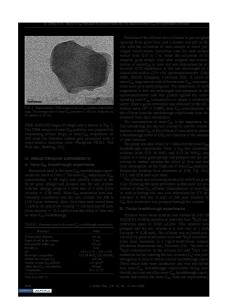A density functional theory based comparative study of hybrid photoemissions from Cl@C 60 , Br@C 60 and I@C 60
- PDF / 859,800 Bytes
- 8 Pages / 595.276 x 785.197 pts Page_size
- 85 Downloads / 329 Views
THE EUROPEAN PHYSICAL JOURNAL D
Regular Article
A density functional theory based comparative study of hybrid photoemissions from Cl@C60, Br@C60 and I@C60? Dakota Shields1 , Ruma De1 , Esam Ali1 , Mohamed E. Madjet2 , Steven T. Manson3 , and Himadri S. Chakraborty1,a 1
2 3
Department of Natural Sciences, D.L. Hubbard Center for Innovation, Northwest Missouri State University, Maryville, MO 64468, USA Qatar Environment and Energy Research Institute, Hamad Bin Khalifa University, P.O. Box 34110, Doha, Qatar Department of Physics and Astronomy, Georgia State University, Atlanta, GA, USA Received 6 March 2020 / Received in final form 15 July 2020 / Accepted 21 July 2020 Published online 22 September 2020 c EDP Sciences / Societ`
a Italiana di Fisica / Springer-Verlag GmbH Germany, part of Springer Nature, 2020 Abstract. Photoionization from atom-C60 hybrid levels in halogen endufullerene molecules, Cl@C60 , Br@C60 and I@C60 , is calculated using a linear response density functional method. Both the ordinary electron-configuration where the open shell halogen is at the center of C60 and the stable configuration after the atom receives an electron from C60 to form a closed shell anion are considered. Similar ground state hybridization is found for all three systems while, in general, a slight weakening of the effect is noticed after the electron transfer. At lower photon energies, cross sections of the outer hybrid levels attain identical shapes from enhancements driven by the C60 plasmon resonances, while the higher energy emissions remain distinguishable from the differences in atomic responses. These results further show near insensitivity to the choice of a configuration. The inner hybrid cross sections in general exhibit similar overall structures, although differ in details between molecules. However, for these states the results significantly differ before and after the electron transfer – a feature that can be useful to experimentally determine the real configuration of the molecules via photoelectron spectroscopy.
1 Introduction Spectroscopict research on solid phase and gas phase endo-fullerenes – an atom or a smaller molecule taken captive inside a fullerene [1] – is important to generate a knowledge repository. This may find fundamental use in prospective applications of these nanosystems which include quantum computations [2,3], organic photovoltaics [4], superconductivity [5] and biomedical sciences [6], including possible applications in cancer treatments as sensitizers similar to how metal nanoparticles are used [7]. Merged beam techniques were employed at the ALS at Berkeley to probe photoionization properties of atomic endofullerenes experimentally [8–10]. It may be possible in future to employ photoelectron spectroscopy techniques [11] to access level-selective measurements as well. Theoretical model studies of the photoresponse of closed-shell atomic endofullerenes are aplenty; some accounts can be found in the review articles references [12] and [13]. Studies have regularly predicted hybridizat
Data Loading...











